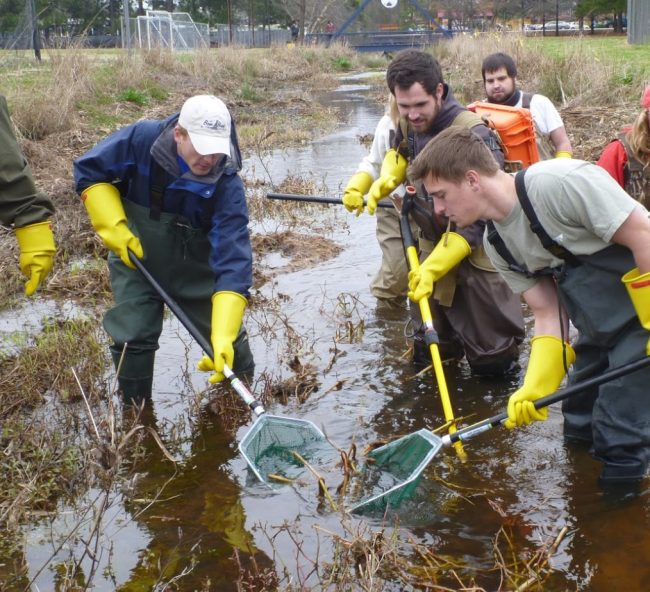Georgia Southern University biologists quantify campus biodiversity
 Squirrels and robins are a common sight on almost any college campus. But is the park-like landscape of a campus actually a good habitat for wildlife? How many other species live in the fields, forests and waters of a university campus?
Squirrels and robins are a common sight on almost any college campus. But is the park-like landscape of a campus actually a good habitat for wildlife? How many other species live in the fields, forests and waters of a university campus?
Faculty and students at Georgia Southern University have just completed a two-year study to answer these questions. The study, organized by biology professors Michelle Cawthorn, Ph.D., Ray Chandler, Ph.D., Lance McBrayer, Ph.D., and Jamie Roberts, Ph.D., was funded by the University’s Center for Sustainability (CfS).
With the help of dozens of students, the scientists observed, live-trapped, netted, audio-recorded or photographed 207 species of vertebrates (fish, amphibians, reptiles, birds and mammals) on the Georgia Southern University campus. This impressive diversity includes 19 species of fish, 19 amphibians, 24 reptiles, 126 birds and 19 mammals.
“These numbers are not just an answer to a trivia question for biology class,” explained Chandler. “The number of species our campus supports is an indicator of the health of our campus environment and a measure of how sustainably we are managing that environment.”
Because the study mapped the location of every animal found, future construction and other development can be done in a way that minimizes impacts on biodiversity.
There are educational benefits as well because a biodiverse campus is a living laboratory that students and faculty can use just by walking outside their building.
“The ultimate goal is to manage our campus in a way that in 50 or 100 years it will still support these 207 vertebrate species, or hopefully more,” said McBrayer. “We know that some species have disappeared from campus since the 1970s. We don’t want to make that mistake again.”
The results of the survey are available to anyone through the iNaturalist website or smartphone application. The project, titled “Georgia Southern Biological Survey,” includes a list of all the species observed, a map of where individuals were seen, and documentary photos for most of the species.
An important feature of the application is that anyone on campus can add to the data.
“If you encounter a vertebrate on campus, you can snap a photo with your smartphone, go to the application and upload your sighting,” said Rebecca Scott, the biology graduate student who created the site for the project.
“This type of citizen science is a great way to engage students and the community in gathering important biological data,” added Roberts.
The Georgia Southern Biological Survey is among the most comprehensive of any university in the country, and it is unique in the state.
“A logical next step is to expand the survey from campus to the city of Statesboro to help them with their environmental planning and sustainability,” said Cawthorn. “We would like our campus and community to be leaders in the conservation of biodiversity.”
To read the full study, visit https://www.inaturalist.org/projects/georgia-southern-biological-survey.
Georgia Southern University, a public Carnegie Doctoral/Research University founded in 1906, offers 118 degree programs serving 20,673 students. Through eight colleges, the University offers bachelor’s, master’s and doctoral degree programs built on more than a century of academic achievement. Georgia Southern is recognized for its student-centered and hands-on approach to education. Visit GeorgiaSouthern.edu.
Posted in Faculty Highlights, Press Releases, University Homepage

